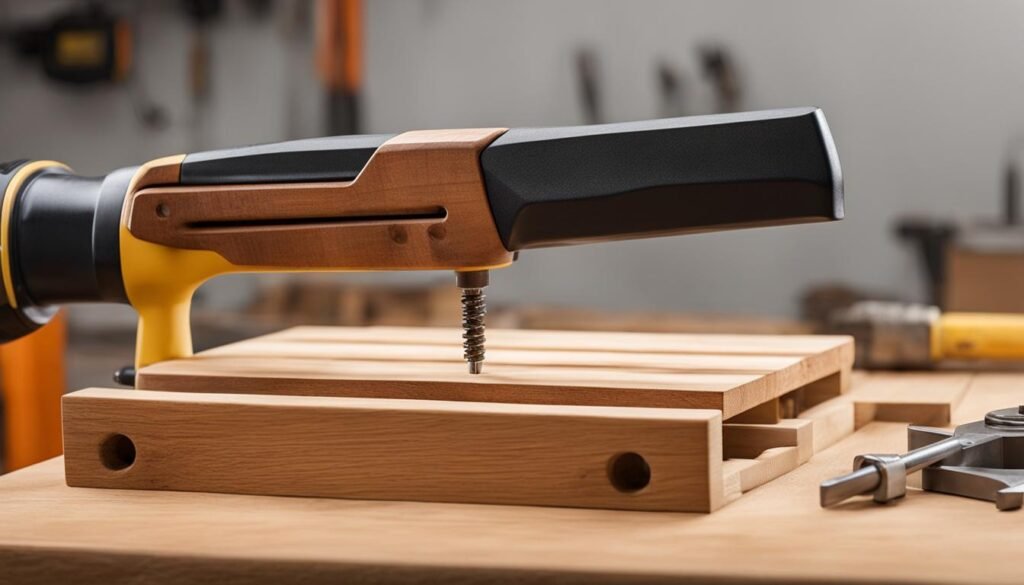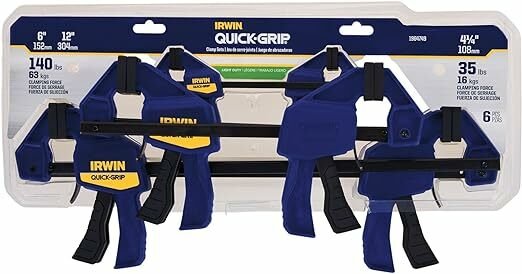Woodworking clamps are essential tools for woodworkers and DIY enthusiasts. Finding the right clamp for your projects is important, as each clamp is designed for specific tasks. In this article, we will explore the different types of clamps available and provide recommendations for the best woodworking clamps based on their features and uses.
Key Takeaways:
- Woodworking clamps are essential tools for woodworkers and DIY enthusiasts.
- Choosing the right wood clamp is crucial for the success of your projects.
- There are various types of clamps available, including F-style clamps, parallel clamps, trigger clamps, bar clamps, hand clamps, band clamps, corner clamps, hand screw clamps, toggle clamps, panel clamps, and more.
- Consider the specific requirements of your woodworking projects when selecting a wood clamp.
- By choosing the perfect wood clamp for your project needs, you can ensure a secure and successful woodworking experience.
Understanding F-Style Clamps
F-style clamps, also known as woodworking clamps or universal clamps, are a versatile tool for woodworkers and DIY enthusiasts. They are named for their shape, which resembles the letter “F,” with a long handle and two metal jaws mounted to steel bars. These clamps are commonly found in woodworking shops and are essential for various tasks.
One of the key advantages of F-style clamps is their ability to adjust to fit the thickness of the wood being held. This makes them suitable for clamping down boards or panels of different sizes. Whether you are working on a small project or a large-scale woodworking endeavor, F-style clamps can securely hold your workpieces in place.
Aside from their versatility, F-style clamps are also cost-effective, making them an affordable option for woodworkers on a budget. These clamps are considered a universal clamp due to their wide range of uses, making them a must-have tool in any woodworking toolbox.
F-style clamps are a popular choice among woodworkers for their versatility, affordability, and ease of use. Whether you are building furniture, constructing cabinets, or working on smaller woodworking projects, F-style clamps provide the necessary stability and pressure to ensure precise and secure joints.
When selecting F-style clamps for your projects, consider factors such as the maximum clamping capacity, throat depth, and overall durability. Investing in high-quality F-style clamps will ensure their longevity and reliable performance in your woodworking endeavors.
Table: Comparison of F-Style Clamps
| Clamp Model | Maximum Clamping Capacity | Throat Depth | Price Range |
|---|---|---|---|
| Clamp Model 1 | 4 inches | 3 inches | $10 – $20 |
| Clamp Model 2 | 6 inches | 4 inches | $20 – $30 |
| Clamp Model 3 | 8 inches | 5 inches | $30 – $40 |
The table above provides a comparison of different F-style clamps available on the market. The maximum clamping capacity and throat depth are important factors to consider when choosing the right clamp for your projects. Additionally, the price range can vary depending on the brand and quality of the clamp.
Overall, F-style clamps are an essential tool for woodworkers of all skill levels. Their versatility, affordability, and ease of use make them a valuable asset in any woodworking workshop.
Exploring Parallel Clamps
When it comes to woodworking projects, having the right clamps can make all the difference. Parallel clamps, also known as cabinet clamps, are a popular choice among woodworking enthusiasts. These clamps feature parallel jaws that apply even pressure across the entire work surface, ensuring a secure hold on your materials.
Parallel clamps are particularly ideal for high-pressure clamping of larger projects that require clamping at a 90-degree angle. They are commonly used in cabinet making or large furniture projects due to their ability to provide more clamping pressure and throat depth than other types of clamps.
One of the standout features of parallel clamps is their ergonomic handle, which provides a comfortable grip while applying pressure. This makes them easy to use for extended periods of time without causing discomfort or fatigue. Additionally, parallel clamps are known for their durability and reliability, making them a staple in any woodworking shop.
Benefits of Parallel Clamps:
- Even pressure distribution across the entire work surface
- High clamping pressure and throat depth for larger projects
- Ergonomic handle for comfortable use
- Durable and reliable
Whether you’re working on a cabinet, a dining table, or any other woodworking project that requires secure clamping, parallel clamps are an excellent choice. Their ability to provide even pressure and strong grip makes them an essential tool for achieving precise and professional results.
Now that we’ve explored parallel clamps, let’s move on to our next section, where we’ll discuss the versatility of trigger clamps for woodworking projects.
The Versatility of Trigger Clamps
Trigger clamps, also known as quick grip clamps, are versatile and fast-action clamps that are widely used in woodworking projects. These clamps are designed to provide a quick and secure grip, making them ideal for various applications. With their ergonomic pistol grip handle and trigger mechanism, trigger clamps are incredibly easy to use with just one hand. They offer convenience and efficiency, especially for DIY enthusiasts and new woodworkers.
“Trigger clamps are popular among woodworkers for their ease of use and ergonomic design.”
The soft jaw caps of trigger clamps ensure that they do not damage the wood during clamping. This is particularly important when working on delicate or finished surfaces. They exert a strong clamping force, allowing for secure and reliable holding of workpieces. Trigger clamps are commonly used for tasks such as gluing, drilling, sanding, and assembling. They are also great for holding materials in place while waiting for adhesives to dry.
Key Features:
- Quick and easy one-handed operation
- Ergonomic pistol grip handle
- Soft jaw caps to protect the workpiece
- Strong clamping force for secure holding
- Wide range of applications in woodworking projects
Benefits of Trigger Clamps:
- Convenience: Trigger clamps can be easily operated with just one hand, allowing users to have better control and freedom of movement during projects.
- Time-saving: The fast-action mechanism of trigger clamps enables quick and efficient clamping, saving valuable time and effort.
- Versatility: These clamps are suitable for a wide range of woodworking tasks, from simple gluing to more complex assembly work.
- Gentle on Surfaces: The soft jaw caps of trigger clamps prevent damage to the workpiece, making them safe to use on delicate materials.
- Reliable Holding: Trigger clamps exert a strong clamping force, ensuring that workpieces are securely held in place for precise and accurate woodworking.
| Pros | Cons |
|---|---|
| Easy one-handed operation | May not provide as much clamping force as other types of clamps |
| Quick and efficient clamping | Not suitable for heavy-duty projects |
| Soft jaw caps to protect surfaces | Limited throat depth for clamping thicker materials |
| Versatile applications in woodworking | May not be suitable for clamping angled or irregular shapes |
| Reliable and secure holding |
Bar Clamps for Heavy-Duty Use
In the world of woodworking, when it comes to heavy-duty clamping, bar clamps are a go-to choice. Also referred to as pipe clamps or h-style pipe clamps, these robust tools are specifically designed to handle demanding projects with ease. Bar clamps consist of pipe clamp fixtures on either end of a black pipe, providing a sturdy and adjustable clamping mechanism.
One of the key advantages of bar clamps is their versatility in terms of length. They are available in various sizes, allowing for a wide clamping surface area. This flexibility makes them particularly useful for large projects that require a significant amount of pressure across a wide surface area, such as kitchen table tops or large panel glue-ups.
| Advantages of Bar Clamps | Disadvantages of Bar Clamps |
|---|---|
| Ability to provide a wide clamping surface area | May be more expensive compared to other clamp types |
| Designed for heavy-duty use | Requires additional space for storage due to their length |
| Provides even pressure across the workpiece | Can be heavier and more challenging to transport |
When using bar clamps, it’s important to ensure proper alignment and tightness to achieve the desired results. The sliding head of the clamp allows for easy adjustments and locking to provide secure clamping pressure. The sturdy construction of bar clamps ensures durability and reliability, making them an essential tool for any woodworking workshop.
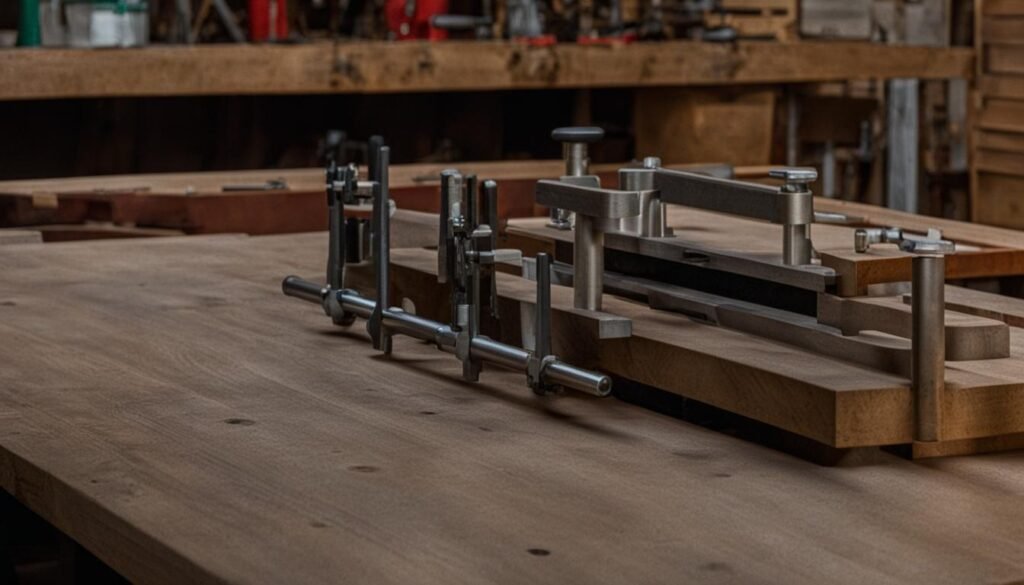
Choosing the Right Bar Clamp
When selecting a bar clamp, it’s crucial to consider the length and throat depth based on the size of your projects. The length should be suitable for the width of the workpiece, ensuring adequate coverage for effective clamping. The throat depth determines the maximum thickness of the material the clamp can handle. It’s important to choose a clamp with a throat depth that accommodates your project’s requirements.
Additionally, consider the material of the pipe and the strength of the clamp fixtures. High-quality bar clamps typically feature durable steel or iron pipes and robust fixtures that can withstand heavy pressure without flexing or bending. This ensures stability and reliability during clamping.
In conclusion, bar clamps are a versatile and essential tool for heavy-duty woodworking projects. With their adjustable length, even pressure distribution, and sturdy construction, they provide the necessary strength and stability for successful glue-ups and secure clamping. When selecting a bar clamp, ensure it has the appropriate length and throat depth for your projects, and opt for high-quality materials and fixtures for long-lasting performance.
Hand Clamps for Small Projects
Hand clamps, also known as spring clamps, are versatile tools that can be used in various ways in a woodworking shop. They are small, easy to use, and provide a small area of clamping pressure. Hand clamps are typically used to hold pieces of wood together or small items while they are being glued. They come in different sizes and are sold in large packs. Hand clamps are commonly used for holding small or delicate pieces during woodworking projects.
When working on intricate or delicate projects, hand clamps provide the ideal solution for securing pieces in place without causing damage. They have a simple design with a spring-loaded mechanism that allows for quick and easy clamping. Hand clamps are perfect for holding small parts together while applying glue or for securing lightweight materials during sanding or finishing.
One of the advantages of hand clamps is their versatility. They can be used in a wide range of woodworking applications, from crafting small furniture pieces to assembling intricate crafts. Due to their small size and lightweight nature, hand clamps are portable and can be easily carried from one work area to another.
| Type of Clamp | Uses | Key Features |
|---|---|---|
| Hand Clamps | Hold pieces of wood together | Small size, easy to use |
| Spring Clamps | Secure lightweight materials | Spring-loaded mechanism |
Whether you are a beginner or an experienced woodworker, hand clamps are an essential tool in any woodworking shop. Their versatility, ease of use, and ability to provide a small area of clamping pressure make them a valuable asset for holding pieces together during various woodworking tasks. Consider adding hand clamps to your collection of tools to ensure precision and stability in your small woodworking projects.
Band Clamps for Unique Shapes
Band clamps, also known as strap clamps, are a versatile type of woodworking clamp that is perfect for gluing up boxes or odd-shaped projects that require unique clamping pressure. These clamps use a flexible strap to wrap around the workpiece and provide pressure to hold the pieces together securely. The strap is usually made of high-quality nylon or rubber with adjustable tensioning mechanisms, allowing for precise control over the clamping pressure. Band clamps have rubber jaws along the strap to prevent marring or damage to the wood.
One of the advantages of using band clamps is their ability to apply even pressure across irregular shapes or curved surfaces, ensuring a tight and uniform bond. They are commonly used for complex miter joints or boxes with mitered edges, as they allow for the perfect alignment and glue-up of these intricate joints. Band clamps are also useful for gluing up segmented turnings, bent laminations, and other projects that require precise and consistent pressure distribution.
When using band clamps, it’s important to ensure that the straps are tightened evenly and that the workpiece is properly aligned. This will ensure a strong and seamless bond between the pieces. Additionally, it’s worth noting that band clamps are available in various lengths and widths to accommodate different project sizes and shapes.
Recommended Band Clamps
Here are some highly recommended band clamps for woodworking projects:
- Brand A Band Clamp: This band clamp features a sturdy nylon strap with a ratcheting mechanism for easy tightening. It has a maximum clamping capacity of 12 inches, making it suitable for smaller projects.
- Brand B Professional Strap Clamp: This professional-grade band clamp offers a longer strap length of 20 feet, allowing for clamping larger and more complex shapes. It also has a quick-release mechanism for easy removal.
- Brand C Adjustable Band Clamp: This versatile band clamp comes with adjustable corner brackets, making it ideal for holding corners at different angles. It has a durable rubber strap and a maximum clamping capacity of 18 inches.
| Brand | Maximum Clamping Capacity | Strap Length | Special Features |
|---|---|---|---|
| Brand A | 12 inches | 10 feet | Ratcheting mechanism |
| Brand B | Unlimited | 20 feet | Quick-release mechanism |
| Brand C | 18 inches | 12 feet | Adjustable corner brackets |
Band clamps are an essential tool for any woodworker who needs to tackle unique shapes and angles. Their ability to provide even pressure and flexibility makes them ideal for gluing up complex projects. Whether you’re working on miter joints, boxes, or bent laminations, band clamps will ensure a strong and seamless bond. Consider investing in a high-quality band clamp that suits your project needs, and you’ll be amazed at the precision and results they can deliver.
Achieving Precise Corners with Corner Clamps
When it comes to woodworking projects that require precise corners, corner clamps are an invaluable tool. These clamps are specifically designed to securely hold two pieces of wood together at a 90-degree angle, ensuring accurate and stable joints. Whether you’re working on picture frames, cabinet doors, or other complex woodworking projects, corner clamps act as an extra set of hands, providing stability during assembly or construction.
Corner clamps are easy to use and offer excellent control and accuracy. They typically feature adjustable jaws that can accommodate different thicknesses of wood, ensuring a snug fit and preventing any movement during the gluing or fastening process. The jaws of corner clamps often have non-marring surfaces or soft pads to protect the wood from scratches or damage.
Whether you’re a beginner or an experienced woodworker, corner clamps are a must-have tool in your workshop. They provide the stability and precision necessary to create strong and clean corner joints in your woodworking projects. So if you’re looking to achieve perfectly aligned corners, invest in a set of corner clamps and take your woodworking craftsmanship to the next level.
The Benefits of Hand Screw Clamps
Hand screw clamps, also known as traditional clamps, are versatile tools that have been used in woodworking for centuries. These clamps are known for their simplicity and effectiveness, making them a popular choice among beginners and experienced woodworkers alike.
One of the key benefits of hand screw clamps is their long reach and throat depth. This allows them to securely hold boards and panels together, even at a distance. Whether you’re working on a small project or a large panel glue-up, hand screw clamps provide the necessary clamping force to keep your pieces in place.
Another advantage of hand screw clamps is their versatility. Unlike some specialized clamps, hand screw clamps can hold objects vertically, making them ideal for a wide range of woodworking tasks. From securing workpieces for routing or sanding to assembling complex joints, hand screw clamps offer the flexibility needed in a woodworking shop.
Furthermore, hand screw clamps are durable and built to last. Made from high-quality materials like hardwood or metal, these clamps can withstand the rigors of woodworking projects. Their sturdy construction ensures that they can provide reliable clamping force for many years to come.
Overall, hand screw clamps are a valuable addition to any woodworker’s toolbox. Their simplicity, versatility, and durability make them an essential tool for securing and holding workpieces during woodworking projects. Whether you’re a beginner or an experienced woodworker, hand screw clamps are sure to enhance your woodworking experience.
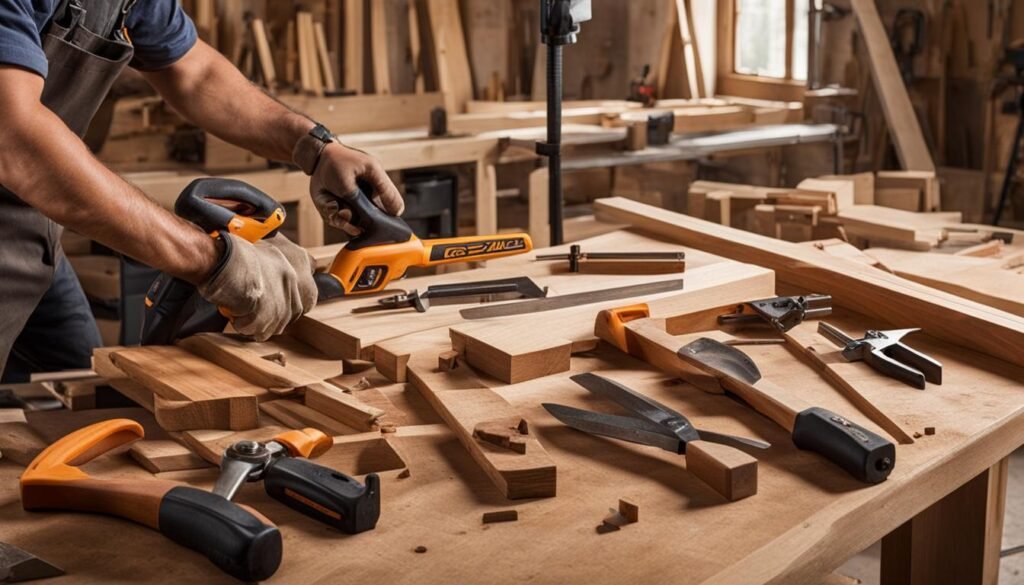
Table: Comparison of Hand Screw Clamps
| Brand | Throat Depth | Maximum Opening | Material |
|---|---|---|---|
| Brand A | 8 inches | 10 inches | Hardwood |
| Brand B | 10 inches | 12 inches | Hardwood |
| Brand C | 6 inches | 8 inches | Metal |
| Brand D | 12 inches | 14 inches | Metal |
Table: Comparison of Hand Screw Clamps
- Brand A offers a throat depth of 8 inches and a maximum opening of 10 inches. It is made from hardwood, providing both strength and durability.
- Brand B has a slightly larger throat depth of 10 inches and a maximum opening of 12 inches. It also features a hardwood construction for long-lasting use.
- Brand C offers a throat depth of 6 inches and a maximum opening of 8 inches. It is made from metal, providing a sturdy and reliable clamping force.
- Brand D has the largest throat depth of 12 inches and a maximum opening of 14 inches. It is also made from metal, ensuring durability and strength.
These are just a few examples of the various hand screw clamps available on the market. When choosing a hand screw clamp, consider factors such as throat depth, maximum opening, and material to find the one that best suits your woodworking needs.
Using Bandy Clamps for Edge Banding
When it comes to edge banding in woodworking projects, bandy clamps are an invaluable tool. These specialized clamps are designed to provide temporary clamping pressure without the need for nails or screws, resulting in a cleaner and more efficient edge banding process. Bandy clamps wrap a strap around the workpiece, ensuring a tight and secure hold during the gluing process.
One of the main advantages of using bandy clamps for edge banding is the time-saving factor. By eliminating the need to fill nail holes and wait for them to dry, the bandy clamp allows for a more streamlined workflow. Additionally, the clamp’s rubber jaws prevent any marring or damage to the wood, ensuring a clean and professional finish.
Woodworking projects that involve using hardwood lumber to edge band plywood can greatly benefit from the use of bandy clamps. These clamps offer a secure and reliable hold, resulting in strong and durable edge bands. Whether you are working on cabinets, furniture, or other woodworking projects, bandy clamps are an essential tool in achieving a professional and polished look.
Toggle Clamps for Secure Holding
Toggle clamps are a popular choice among woodworkers when it comes to securing workpieces on a workbench. These clamps utilize a toggle action to apply pressure and securely hold the workpiece in place, allowing for precise and safe woodworking tasks. Whether you’re sanding, drilling holes, routing, or using hand tools, toggle clamps provide the stability and security needed for a variety of woodworking projects.
“Toggle clamps are a game-changer in my woodworking shop. They are incredibly easy to use and provide a reliable hold, giving me peace of mind while working on delicate or intricate pieces. The toggle action allows for quick adjustment and ensures a secure grip while keeping my hands free to focus on the task at hand.”
One of the key benefits of toggle clamps is their ability to maintain pressure without constant adjustments. This makes them particularly useful for repetitive tasks, as you can set the desired pressure once and rely on the clamp to hold the workpiece securely throughout the entire process. Toggle clamps come in various types, including horizontal, vertical, in-line, and latch-action clamps, allowing for versatility in different woodworking applications.
Benefits of Toggle Clamps:
- Quick and easy to use
- Securely hold workpieces in place
- Stable and reliable for precise woodworking
- Maintain pressure without constant adjustments
- Versatile with different types for various applications
Whether you’re a professional woodworker or a DIY enthusiast, having a set of toggle clamps in your workshop can greatly enhance your woodworking experience. Their sturdy construction and ability to securely hold workpieces make them an essential tool for any woodworking project. So if you’re looking for workbench clamps that provide secure holding power, toggle clamps are the go-to choice.
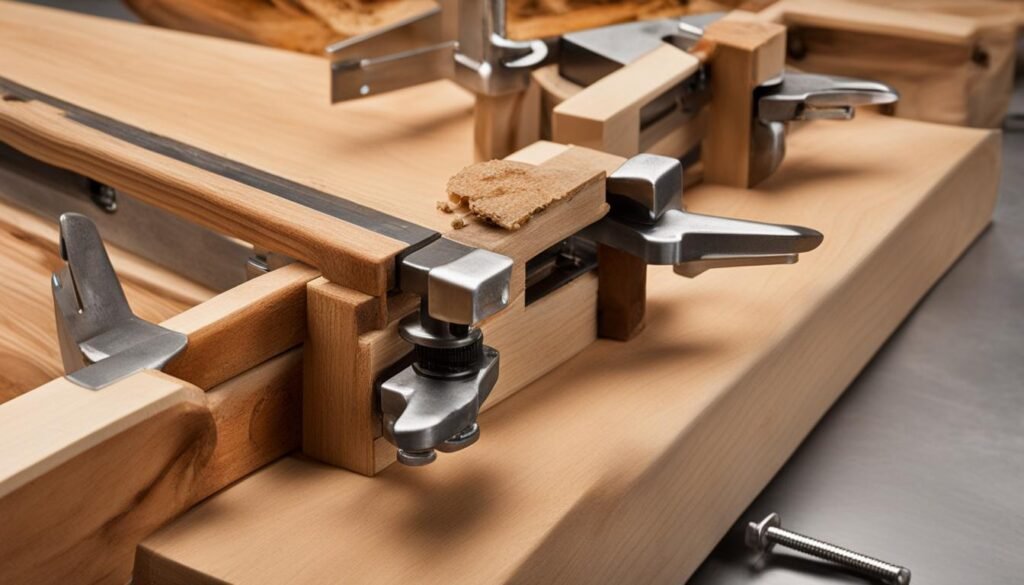
Panel Clamps for Gluing Large Panels
When it comes to gluing large panels together, panel clamps are a valuable tool that provides secure and aligned joints. These clamps apply pressure on all four sides of the panel, ensuring a strong bond while the glue dries. They eliminate the need for additional reinforcements like biscuits or dowels, making the assembly process more efficient.
Panel clamps are particularly useful for creating sturdy panels for furniture construction or cutting boards. The even pressure they provide ensures that all sides of the panel are held firmly in place, resulting in a flat and stable surface. Whether you’re working on a table top, cabinet door, or other large woodworking projects, panel clamps are essential for achieving professional-quality results.
To give you a better understanding of the benefits and features of panel clamps, here’s a table summarizing their key attributes:
| Features | Benefits |
|---|---|
| Pressure on all four sides | Ensures a secure and aligned joint |
| No need for additional reinforcements | Efficient and streamlined assembly process |
| Suitable for large panels | Ideal for furniture construction and cutting boards |
With panel clamps, you can confidently tackle woodworking projects that involve gluing large panels. Their reliable performance and ease of use make them a must-have tool for any woodworker or DIY enthusiast.
Conclusion
In conclusion, finding the perfect wood clamp for your project needs is essential. Woodworking clamps are crucial tools for woodworkers and DIY enthusiasts, as they provide the necessary pressure and stability during various woodworking tasks. Whether you’re clamping down boards, gluing large panels, or securing delicate pieces, there is a wide range of woodworking clamps available to suit your specific requirements.
F-style clamps, parallel clamps, trigger clamps, bar clamps, hand clamps, band clamps, corner clamps, hand screw clamps, and toggle clamps are just a few examples of the many options available in the market. Each type of clamp has its unique features and uses, so it’s important to consider the demands of your woodworking projects when making a decision.
By selecting the right wood clamp, you can ensure a secure and successful woodworking experience. So, take the time to evaluate your project needs, consider the features and functionality of different clamps, and make an informed choice. Whether you’re a beginner or an experienced woodworker, the right wood clamp can make a significant difference in the quality and efficiency of your woodworking projects.
FAQ
What are the different types of clamps available for woodworking?
The different types of clamps available for woodworking include F-style clamps, parallel clamps, trigger clamps, bar clamps, hand clamps, band clamps, corner clamps, hand screw clamps, bandy clamps, toggle clamps, and panel clamps.
What is the purpose of F-style clamps?
F-style clamps are universal clamps that are commonly used for clamping down boards or panels.
What are parallel clamps used for?
Parallel clamps are ideal for high-pressure clamping of larger woodworking projects that require clamping at a 90-degree angle.
What are the benefits of trigger clamps?
Trigger clamps are versatile and fast-action clamps that are easy to use with one hand. They are popular among woodworkers for their ergonomic design and soft jaw caps that prevent damage to the wood.
When should bar clamps be used?
Bar clamps are designed for heavy-duty use and are commonly used in woodworking for kitchen table tops or large panel glue-ups.
What are hand clamps used for?
Hand clamps, also known as spring clamps, are versatile tools that are commonly used for holding small or delicate pieces together during woodworking projects.
How are band clamps used in woodworking?
Band clamps, also known as strap clamps, are perfect for gluing up boxes or odd-shaped woodworking projects that require unique clamping pressure.
What are corner clamps used for?
Corner clamps securely hold two pieces of wood together at a 90-degree angle, making them ideal for projects such as picture frames and cabinet doors.
What are the benefits of hand screw clamps?
Hand screw clamps are easy to use, versatile, and have a long reach and throat depth, making them perfect for securing boards and panels together.
What are bandy clamps used for in woodworking?
Bandy clamps are designed specifically for edge banding and are used to clamp edge banding to a workpiece without the need for nails or screws.
What are toggle clamps used for?
Toggle clamps are commonly used for holding down workpieces securely on a workbench while performing tasks such as sanding, drilling, routing, or using hand tools.
How are panel clamps used in woodworking?
Panel clamps are used for gluing large panels together, providing pressure on all four sides to ensure a secure and aligned joint while the glue dries.
